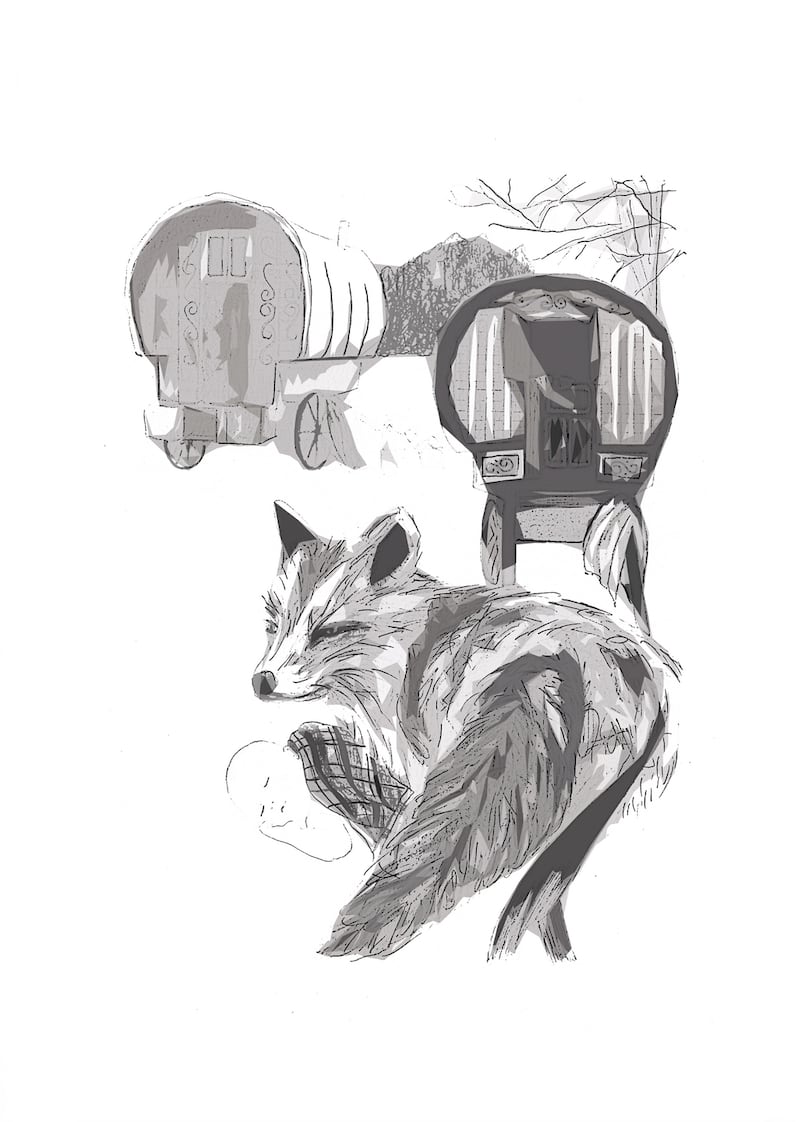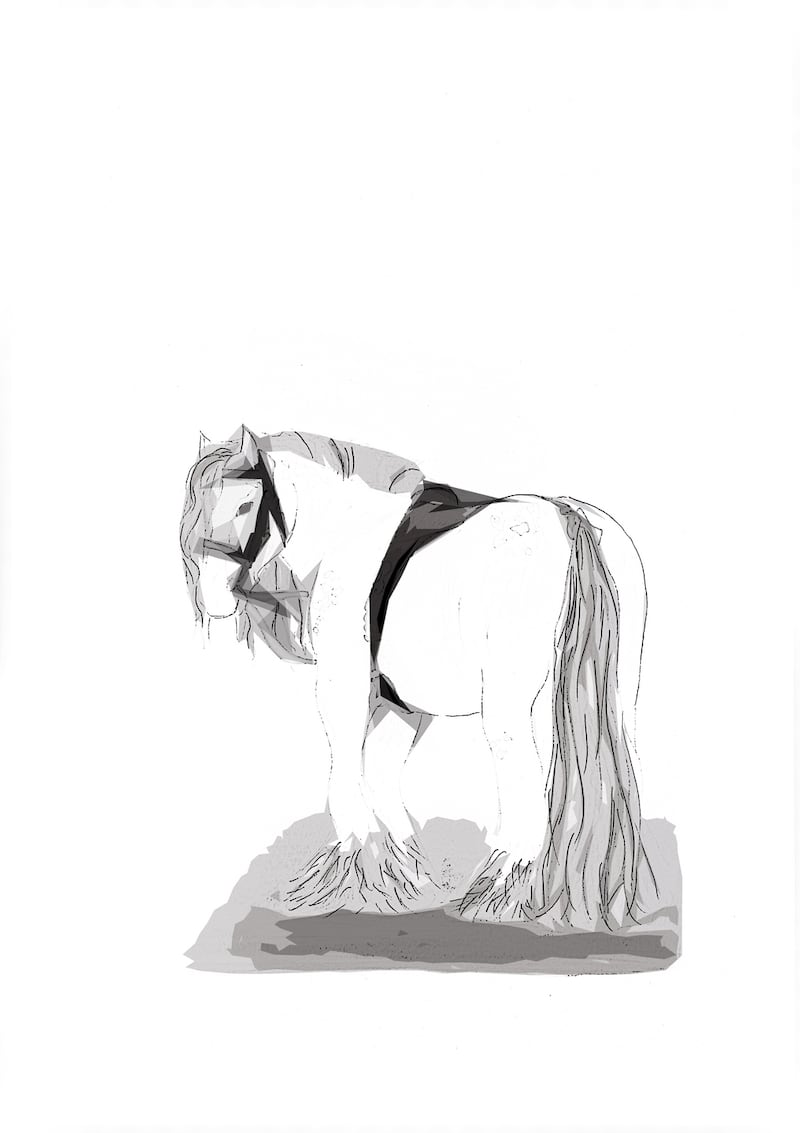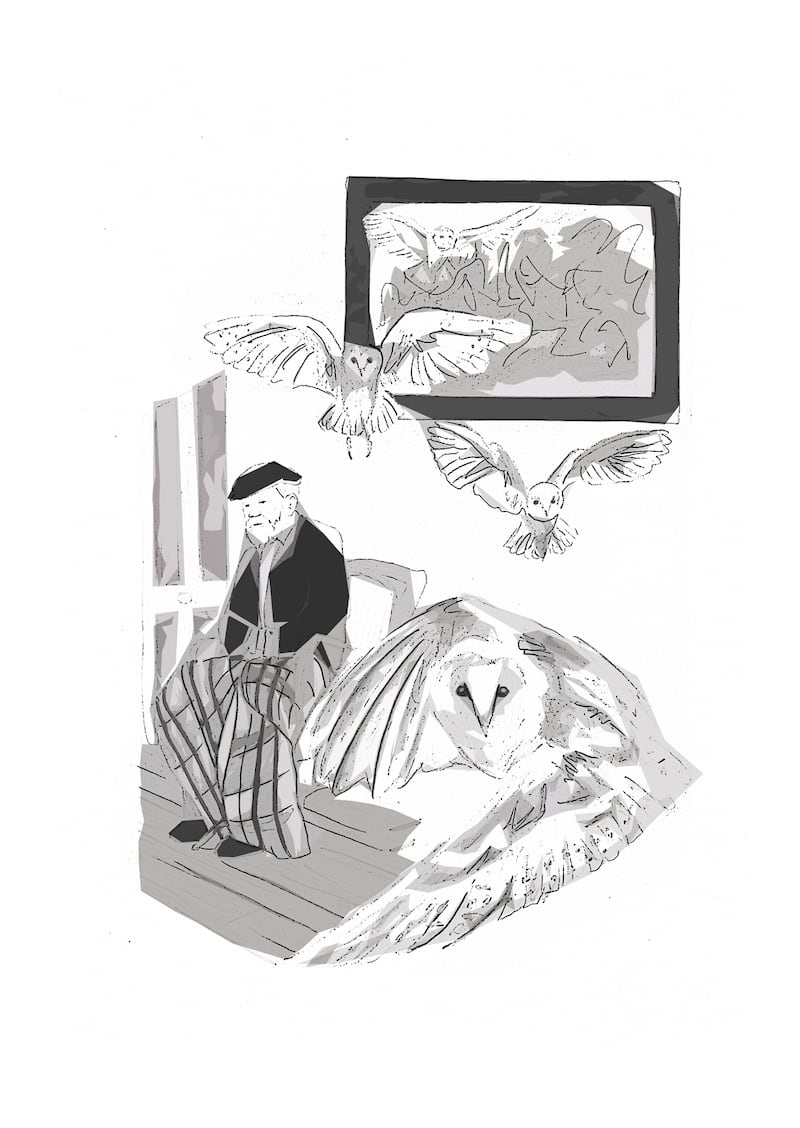“We are all made of stories.”
A simple but striking line from the introduction to Why the Moon Travels, a collection of Traveller folk tales collected and retold by Oein DeBharduin, a writer, folk herbalist, educator and administrator of numerous Minceiri community initiatives.
Illustrated by Leanne McDonagh, it is a beautiful book, immaculately written in clear but inventive language. Prefaced by DeBharduin’s own comments about the stories’ provenance, these often surrealistic narratives invoke the supernatural realm, yet remain rooted in the natural world. It was important, DeBharduin maintains, to simply speak these stories, unmediated by gatekeepers from the settled worlds of anthropology or social studies.
“Loads of people over the years have recorded our stories and presented them to settled people from a Traveller point of view,” DeBharduin says, “but my whole process was to just say the story and record it. Every story, as it’s retold, changes and grows with every storyteller, and that’s one of the most amazing parts of folk tales. The stories become living things, they don’t just become the story, but a story, filled with all this beauty and wildness and madness and clarity and sureness.
A lot of our language is part of the established lingo of Ireland, areas like Limerick
“One of the symptomatic things around Travellers is that we’re researched and considered and analysed, and sometimes people actually know nothing about our culture, only the issues we experience. When I was a child I benefited so much from these stories, they’re part of how I see the world. I wanted to share that with people from the wider community and say, ‘Here are some things you’ve never known about us, and they’re beautiful.’ ”
What’s notable is how closely these stories echo world mythology, from Siberia to North America, west Africa to Tibet. They’re full of shape-changing foxes and spider women and fish’s eyeballs that grow to become stars.
“I think it’s universal, the anthropomorphisation, the world as alive,” Oein suggests. “Most people will recall stories about why the wren became the king of all birds, and why the robin has a red chest, but you’re kind of going, ‘What happened to the rest of your stories?’ And you realise other people have stopped telling their stories too.”

Oral and written
What’s the difference between an oral and written literature?
"When you write down a story, you start to – not to put a pun on it – settle it. It becomes the story. I often found, especially with the Ulster Cycle and the older chronicles, that's just one person's interpretation. That's a risk because once you write it, it becomes somewhat fixed, you come close to that threshold of saying, 'This is the authority.' No, this is just putting out a new voice into the echoes and waiting for you to reply.
“If you are nomadic, your songs and tales don’t become regional, they become national, and almost universal, because they tap into the deeper roots of these experiences rather than one worldview.”
So how did Oein strike a balance between preserving the tradition of Traveller language, the rhythms of Gammon, or Cant, while bringing his own individual voice to the work?
“In the reading of it, there’s obviously Gammon throughout, and that was very natural, I didn’t want to edit that away because that would naturally flow into our conversation – although how we might interpret something on a cultural Traveller level might be very different. Words like ‘taken’, for example, would be associated with embarrassment instead of ‘taking something’.”
As in, ‘You’ll get me taken’? I thought that was a Wexford phrase.
Many indigenous cultures have avatars in their mythology that present themselves as possessing fluid or ambiguous sexuality
“A lot of our language is part of the established lingo of Ireland, areas like Limerick. Things like the legal term ‘moniker’. The word ‘bloke’ is from our language. We got it from somewhere else as well, old Irish and terms that exist in Ogham scriptures and carvings.”
There is, as I’ve suggested, an element of wisdom-giving or guidance sewn into the pockets of these yarns. The opening story, The Yew Tree, which warns against excessive grief, echoes Seneca’s assertion that the maximum period one should mourn is a year, and if you can be done with it before then, so much the better. It is unseemly, he said, to wear the veil too long.
“A year and a day,” Oein responds. “Everything is new, your first birthday, their first birthday, your first Christmas without them, but then it’s over, it’s no longer new to you. If we’re not able to process those experiences and let them go, the dead can fester in us, so we tell ourselves these stories to understand that at a young age.
“You know the one about the women who gather, the spiders? A lot of that is about the unattended, unrecognised labour of women. I had never picked up on that. But they don’t have to be profound, they can just be a story.
“When I finished the book I actually went to my parents and said, ‘Was I spoilt as a child?’ When we were young we worked with them, we had a huge amount of responsibilities, but they recognised that the world isn’t always a kind or safe space, so you fill children as much as possible with love and as many resources as you can. They knew that – unfortunately for many people in minorities, especially Travellers – once you go into the world it can be like going into the battlefield of society, and they wanted us to have as much armour, and positive connective cultural understanding, as possible. And for our family that was through our stories.”
Many indigenous cultures have avatars in their mythology that present themselves as possessing fluid or ambiguous sexuality. As a gay man, did Oein see himself reflected in his own culture?
When people call us Travellers, there's a kind of cognitive dissonance, because people know that nomadism is effectively illegal in Ireland
“At different periods of my life my parents would always say, do whatever you need to do to survive. The world is very harsh, and the more different you may be seen to the world, the less connected people may feel with you. As long as you don’t lose yourself, as long as you are authentically you, do what you need to do. Don’t give yourself up as a sacrifice for something that you never wanted in the first place.
“In Dublin at Pride in June, there’s usually all these stories about young gay male Travellers, and I often find the stories to be so anti-Traveller, like, ‘How bad did the Travellers treat you? Did they reject ya?!’ And I’m going, ‘This is horrible!’ I’ve never had a problem with being a Traveller, being a Traveller is amazing – my problem is with bigots. Coming out, there were struggles and mountains to climb and wild clear oceans to swim just like everyone else. Come and sit and talk to us. We’re just as flawed and as messed up as you are, I swear!”

Dissonance
So many of these stories in this book are about the painful but necessary transformation from one state to another: from naivety to maturity, from death to the spirit world.
“Nature isn’t complicated. Nature doesn’t make promises and break them. Nature doesn’t set up systems for you to have to follow and learn to understand. Nature doesn’t create hierarchies that change because of situations of birth. The rain that falls on the trailer in a site is the same rain that falls on a mansion on the top of the hill. And when life is cruel to us, it’s an anchor, but it’s also a way for us to work through those divisions and confusions which are so human and forever repeating themselves.”
Why the Moon Travels, the title story, may be the most beautiful of all the tales, a metaphysical love story and tragedy that echoes everything from Lorca to Ladyhawke. Why did he choose it as the title?
“It was a line that stuck out to me when we were tidying up the manuscript. I wanted to have something about movement. When people call us Travellers, there’s a kind of cognitive dissonance, because people know that nomadism is effectively illegal in Ireland. So people say, ‘You’re Travellers, but we’re going to make you sedentary.’ There’s this constant conflict. And also, it [reduces] an entire culture down to one action. It’s a very important action, but just the one action.
“I wanted to put that out in an almost subversive way. Nomadism is such a natural part of the world, it’s not just a physical act, but a way of perceiving our lives and how we connect with each other, and is so profound that even the moon does it.”
A celebration
Grainne O’Toole established Skein Press in partnership with Fionnuala Cloke three years ago, with the objective of publishing unrepresented voices in Ireland. Why the Moon Travels is Skein’s second publication: the first was This Hostel Life, by Melatu Uche Okorie, which told the stories of migrant women in a hidden Ireland.
“I had known of Oein’s work and his interest in education and cultural development through my own background in community and human rights. I also became aware of his beautiful writing, and we reached out to him and asked if he would be interested in working on the collection. He has a very interesting process, he’ll record the stories orally, he’ll speak them and think them, it’s almost like they’re in his bloodstream, and then he’ll put them down on paper. Towards the end of the process we would meet with him to work on the editing side if it.
“What’s wonderful about Oein is, he is who he is. He’s a beautiful writer, but he’s also committed to exploring ways that Traveller culture can come to the fore. Often he would say, ‘People know nothing about us, they only know what issues we face as a minority in Ireland, but these issues are not the weight of us, little is known about who we really are.’ I think the book is very much a celebration of his life, and his family life.”

‘Absolute gold’
Born in 1990, the fifth of 10 children, Leanne McDonagh is a Traveller who began practising art at Crawford College of Art & Design in 2007. Five years later she graduated with an honours degree in fine art and a higher diploma in art and design education. As a visual artist, she says, she is dedicated to representing and recording her community from within.
“I’ve always looked at Oein as a fellow artist, always knew he had an amazing way with words. I’ll never forget one of the first things I said to him after we had messaged back and forth for a little bit, I said, ‘Will you please write a book, so that I can buy it?’ And fast-forward, five, seven years later, and I just happened to illustrate it for him.
“When Oein first sent me an extract from one of his pieces, I was like, ‘Oh my God, this is absolute gold.’ The images immediately just came to me. They really brought me back to my childhood, it felt like we had this shared experience. Every story that I read, I could relate to it on a personal level. I’d never been to Connemara until recent years, [but] when I landed on Connemara soil recently I remembered his story, and I felt like I was at home, like I had lived it, like his stories had a shared history with my own, that was heartwarming.
“Mainstream education hasn’t always been at the forefront for a lot of Travellers, they would have been kind of homeschooled, [but] a lot of the stories had lessons in them, you could learn different things from them. Oein himself is a big herbalist, and even the things that he passes down through teachings of his herbalism . . . Because everything has been oral, you don’t get to retain everything, things get lost obviously, and that’s why this book is so amazing.”
Why the Moon Travels is out on September 9th, published by Skein Press











